ECS P67H2-A Review: A visit back to Lucid's Hydra
by Ian Cutress on July 21, 2011 9:00 AM EST- Posted in
- Motherboards
- Lucid
- P67
- ECS
Board Features
| ECS P67H2-A | |
| Market Segment | Performance |
| CPU Interface | LGA 1155 |
| CPU Support | i3/i5/i7 Sandy Bridge |
| Chipset | P67 |
| Base Clock Frequency | 100 MHz by Default, 38.1 MHz to 655.35 MHz |
| DDR3 Memory Speed | 1333 MHz by Default, 1067 MHz to 2133 MHz supported |
| Core Voltage | -200 mV to +630 mV offset |
| CPU Clock Multiplier | CPU Dependent |
| DRAM Voltage | -200 mV to +630 mV offset |
| DRAM Command Rate | Auto, 1T or 2T |
| Memory Slots |
Four DDR3-DIMM Maximum 16 GB, Non-ECC Unbuffered 1067, 1333, 1600, 1867 and 2133 MHz supported |
| Expansion Slots |
3 x PCIe x16 (x16/x16/x0 or x16/x8/x8) 2 x PCIe x1 2 x PCI |
| Onboard SATA/RAID |
2 x SATA 6 Gbps (RAID 0, 1, 5, 10) 4 x SATA 3 Gbps (RAID 0, 1, 5, 10) 2 x eSATA 6 Gbps (Marvell 88SE9128) |
| Onboard |
2 x SATA 6 Gbps 4 x SATA 3 Gbps 3 x Fan Controllers 4 x USB 2.0 headers 1 x USB 3.0 header Power/Reset buttons Debug LED Front Panel Audio header SPDIF output header Serial Port header Front Panel header |
| Onboard LAN | Dual RealTek RTL8111E Gigabit Fast Ethernet Controllers with Teaming |
| Onboard Audio | Realtek ALC892 8-Ch High Definition audio CODEC |
| Power Connectors |
1 x 24-pin ATX 1 x 8-pin 12V |
| Fan Headers |
1 x CPU 1 x SYS 1 x PWR |
| IO Panel |
4 x USB 3.0 Ports (NEC Controllers) 6 x USB 2.0 Ports 1 x PS/2 Port 2 x Gigabit Ethernet 2 x eSATA 6 Gbps 1 x Clear CMOS button 1 x Optical SPDIF output Audio Jacks |
| BIOS Version | 08/04/2011 |
| Warranty Period | 3 Years |
In The Box
6 x locking SATA 6 Gbps cables
USB 3.0 Front Panel
Driver CD
Manual
Quick Start Guide
Nothing too much out of the ordinary from the box bundle - at this level, the USB 3.0 Front panel should be standard (even if you can't use it with two full length GPUs in there), and ECS fill their box with enough SATA cables to plug a drive into every internal SATA port.
Software
We’ve previously looked at ECS’ software package in our coverage of the ECS P67H2-A2 and the ECS H67H2-M. Not much has changed - even the issues I found are still here. For example, the BIOS Live Update utility did not detect the latest version on the website, so I had to search for it manually, the BCLK can only be changed with the right BIOS option enabled, and as the voltage continually switches between states, actually setting it in the OS can be hazardous if you set the idle state high (so the load state goes even higher) or set the load state low (so the idle state goes even lower) - this is all due to the BIOS using voltage offsets, rather than actual values.
eSF (Smart Fan)
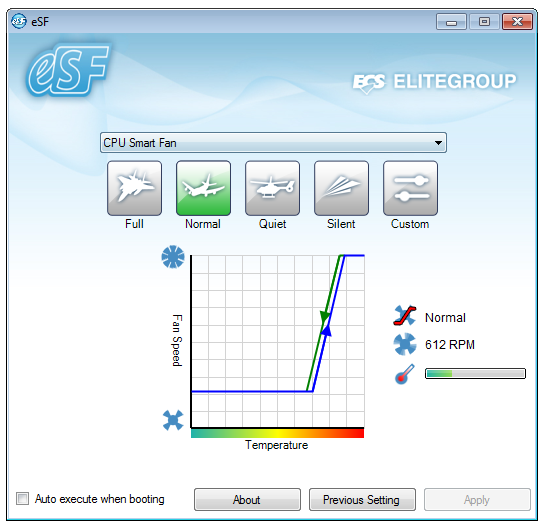
The Smart Fan utility controls the CPU fan header only for the P67H2-A, in either one of the preset modes, or the custom setting allows for hysteresis on the speed up/down modes.
eBLU (BIOS Live Update)
The Live Update software, as mentioned above, could not find the latest version of the BIOS on the ECS servers, and thus I had to search for the BIOS myself.
eDLU (Download Live Update)
The Download Live Update system is not what you think - rather than searching your OS for the state of the drivers, and then probing the ECS servers to check the versions, and asking the user to download them from the software, eDLU is essentially just a link to the driver update page for the P67H2-A on the ECS website.
eGS(Green Saver)

The eGS software is relatively redundant on the Sandy Bridge platform. With this utility, the idea is that the software will reduce the CPU clock speed in idle situations. Sandy Bridge processors do that anyway, reducing to the 16x multiplier when idle.
eOC (Overclocking)
In terms of what we have seen from other overclocking utilities from other manufacturers, eOC is pretty low down on the ladder to begin with - it is essentially software from the socket 775 era software, modified for P67.

The main page is a simple temperature monitor for the CPU and 'System' temperatures. The CPU temperature is measured in terms of PECI, or the number of degrees before the CPU is throttled due to thermal limitations, rather than an absolute value.
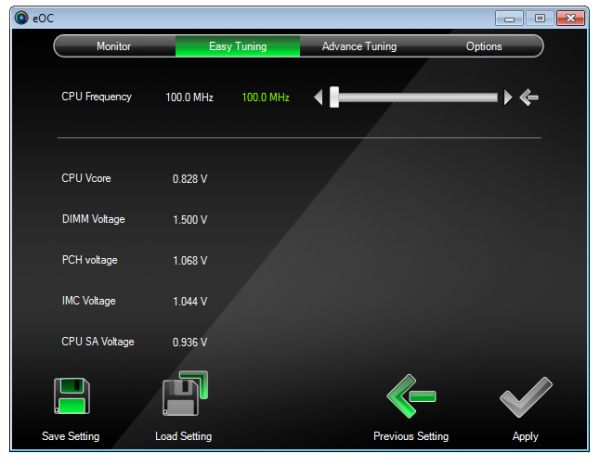
The Easy Tuning tab gives voltages and a CPU Frequency slider, allowing you to adjust the CPU frequency. This slider is the throwback from socket 775 days, when BUS frequencies could reach several hundred MHz—as such, it offers between 100 MHz and 200 MHz in 1 MHz intervals, even though a Sandy Bridge processor can only manage a few MHz due to its integrated clock generator subsystem. Given my stress in getting this option to work when it was on the P67H2-A2, I know now that two obscure BIOS options need to be enabled (both ‘ICC Set Clock Enables’ and ‘Send ICC Lock Registers’) for the eOC software to apply a CPU frequency. As we’re limited to per MHz values, it’s pretty coarsely grained. Also, any change here directly changes the values in BIOS.

The Advance Tuning menu gives you power over the motherboard voltages. These settings work out of the box, but as mentioned previously and found on the P67H2-A2, the issue here is with the CPU voltage. On idle, the CPU will flicker between various low state voltages, and this slider value will flicker too. So if you want to select 1.2 V, you need to make sure what state the CPU is in at the time and apply it at the right moment. If a high voltage is selected at a low CPU state, you could end up with a potentially damaging high voltage in a full CPU load scenario.
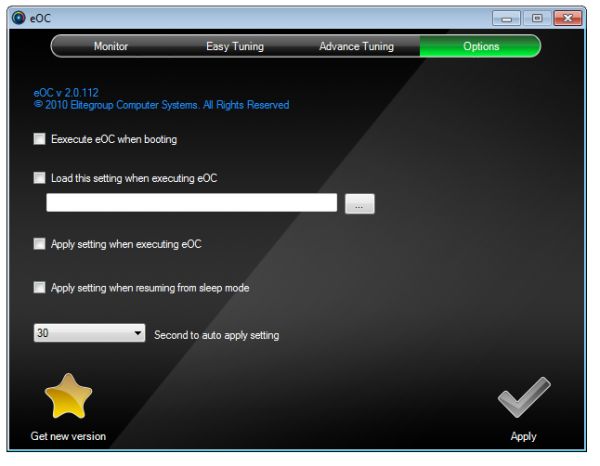
The Options menu, apart from the spelling mistake, doesn’t really do much, apart from enabling a saved eOC to enable itself at bootup.
eJiffy
The eJiffy software is a quick-boot technology which loads the user into a simple Linux interface through which they can access the web. Loading into eJiffy is very quick compared to an SSD and Windows combination, and gives a simple Mozilla type web browser, suitable for when a user wants nothing more than to browse. We covered eJiffy in more detail in our H67 ECS review as it is a pretty neat addition and we rather like it—read here for more details.


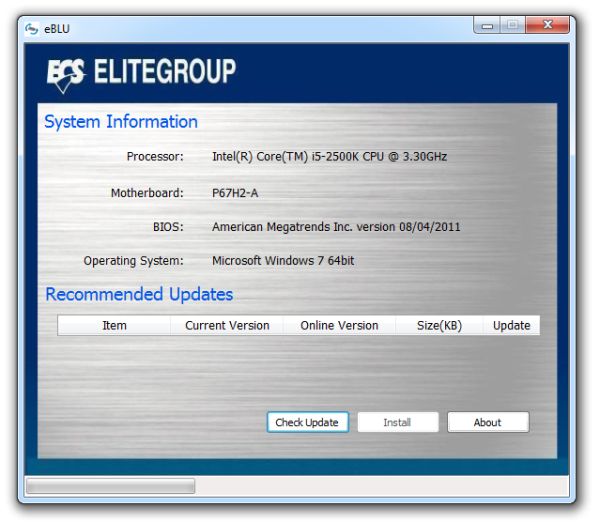
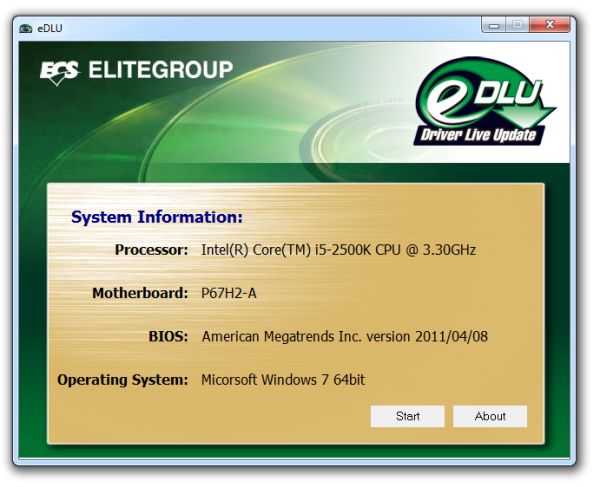
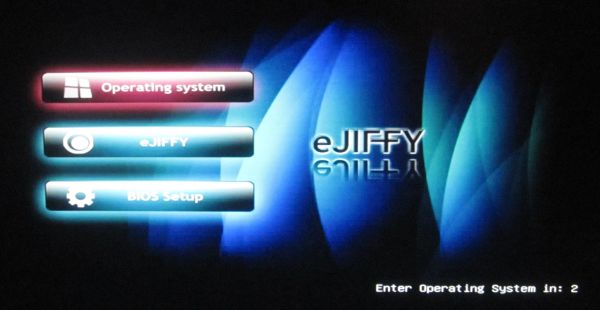








22 Comments
View All Comments
anandtech pirate - Thursday, July 21, 2011 - link
that last photo on the first page makes the board look crooked.also, where's the evo3d review?
Gigantopithecus - Thursday, July 21, 2011 - link
Agreed - some board flexing is to be expected, especially after mounting a massive aftermarket hsf and installation into the case, but that looks a bit ominous for a brand new board straight outta the box! I know it's not terribly reasonable to think less of a board for such a thing, but I can't help but raise an eyebrow as to why a premium board looks like that....Otherwise, thanks for the very thorough review, thanks Ian!
connor4312 - Monday, October 17, 2011 - link
Likely (hopefully) just some lens distortion that wasn't fixed in PS.Hargak - Thursday, July 21, 2011 - link
The word ECS still gives me nightmares. I'm sure things have changed.. I still twitch from flashbacks of early MSI boards..randinspace - Thursday, July 21, 2011 - link
I can't believe you actually ran that many combinations in that many programs for Hydra! It made for quite the fascinating read so great job.ckryan - Thursday, July 21, 2011 - link
are very hit and miss lately.First, if you're a in the business of designing, building, and selling mainbords, why would you try to kick your customers in the [insert place to kick here] with such a prickly, useless UEFI? Further, some of the engineers presumably have sight, so that it left the facory with that kind of graphical uefi is unbelivable. Just looking at the color pictures of the uefi made my eyes hurt with it's yellowish-green and greenish-yellow text on a schizophrenic background. Asus clearly has the (far and away) best graphical UEFI, but the graphical part isn't neccessary if you design the text part is a half way decent fashion. The BIOS and UEFI make or break a board. For instance, Zotac has some good boards with not so great BIOSs, either with dubious or broken or missing functions. Biostar has improved in this area, but was using a text UEFI, then released a grapical upgrade for their 1155's (I have not tried it yet, but have seen some pictures) company that makes boards that should have no excuse for bad BIOS/UEFI designs is Intel (though you could make the case that everything they do should be better). To their credit, they've improved over the last decade substantially. Their DP67BG mainboard had a less than savory UEFI back in January, but has since improved to an almost excellent system. But not graphical, which is okay. I'd rather have a decent text system than graphical one any day of the week, or in ECS's case, never. I just don't get a lot of the decisions mainboard manufacturers are using, especially when this seems like the one area where Taiwanese firms AREN"T "copy and pasting" and just plain stealing from one another.
philosofool - Thursday, July 21, 2011 - link
I honestly don't see the point of GUI BIOS, but I've never used one. The only advantage I can see is building in mouse roll-over stuff so that when I mouse over the menu option, it shows me what's nested in there, but you can do that with arrow key selection too.ckryan - Thursday, July 21, 2011 - link
I think, when done well, a graphical UEFI can provide more information and options. It doesn't actually do anything better per se. In my opinion, no bios provides nearly enough information on settings and options anyway, but some are just abysmal. Even in the mobo's manual you will find vague descriptions which border on absurd. If you do a lot of digging (and you own an Intel extreme series board) you can find Intel's BIOS/UEFI manual which and a performance tuning guide which provides some good guidance about which settings do what and why you would need to use them. If you had only been using AMD, and then switched to a Z/P Sandy Bridge board, you'd probably be a little confused about the options due to the new OC paradigm. I believe that the best motherboard can be ruined with a terrible BIOS or UEFI. UEFI is pretty cool, but if you can't make a good text only implementation, how the hell are you going to make a passable GUI? I'm perfectly happy with a well designed text based UEFI, but I will admit that as much time as I spend with BIOSs and UEFIs, Asus' slick GUI system is clearly in a class by itself. If I were new to the game, I would want something like that on my first build. There just isn't an excuse for terrible BIOS/UEFIs in the year 2011.wifiwolf - Thursday, July 21, 2011 - link
I for instance have been surprised my Asus board gui enables instantly booting from whatever device by clicking in that device in boot section of the bios. Was a nice surprise.Nataku - Friday, July 22, 2011 - link
honestly speaking, for beginner/intermediate users that didn't have to deal with dos, the mouse option does helpbesides, we gotta move forward at some point :P